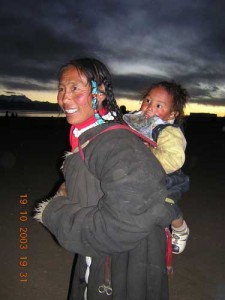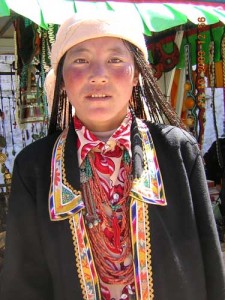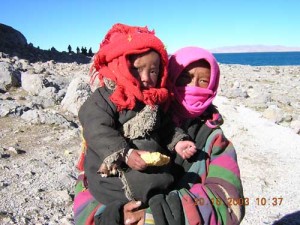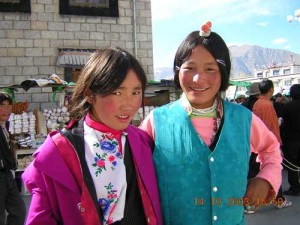Will the forced sterilization of Tibetan women result in the end of the race? This is but one of the serious questions examined by Suzan Crane in this report about the grotesque violations of women’s rights in Tibet.(Originally published in Untamed Travel, September 2005)
 You don’t have to be as politically aware as Richard Gere to be unsurprised by the most recent U.S. State Department’s Country Reports on Human Rights Practices for 2004 which found that Chinese authorities in Tibet “continued to commit serious human rights abuses.” Less well known and more shocking is the way that Tibetan women (girls of four and nuns of 40) are regularly wronged – sterilized, forced into prostitution and routinely abused on a daily basis.
You don’t have to be as politically aware as Richard Gere to be unsurprised by the most recent U.S. State Department’s Country Reports on Human Rights Practices for 2004 which found that Chinese authorities in Tibet “continued to commit serious human rights abuses.” Less well known and more shocking is the way that Tibetan women (girls of four and nuns of 40) are regularly wronged – sterilized, forced into prostitution and routinely abused on a daily basis.
In an oral statement delivered at the 61st Session of the United Nations Commission on Human Rights in April 2005, Dr. B. Tsering Yeshi, addressed these violations. Despite the Beijing Platform for Action (BPFA), which affirmed women’s rights as an inalienable part of all human rights and fundamental freedoms, she asserted that “violence against women continues in its worst forms such as honour killings, genital mutilation and systematic rape of women… some endorsed and enforced by the state. Violence against women becomes a two-fold challenge when women are discriminated against because of their gender and race.”
This report is hardly unique. In 2003, Ms. Radhika Coomaraswamy, then Special Rapporteur on Violence Against Women for the United Nations, said, “Women in Tibet continue to undergo hardship and are also subjected to gender-specific crimes including forced sterilization, forced abortion, coercive birth control policies and the monitoring of menstrual cycles.”
Such observations have been confirmed by personal testimonies. In her 2002 statement to the exiled Tibetan government’s Department of Information and International Relations, Dr. Losersky Gompo, a Tibetan-born, Chinese-educated mobile sterilization doctor, disclosed that China targets rural women, that are often unmarried or childless. According to her declaration, the on-site sterilizations, as well as abortions, were performed under unhygienic circumstances – often by unskilled practitioners – without regard to physical or psychological repercussions.
 Reproductive rights violations of the Convention on the Elimination of All Forms of Discrimination Against Women (CEDAW) were found to be so grave that they “present the possibility that the Tibetan people and culture will be destroyed within the coming century” and CEDAW’s “continued requests for explicit information regarding gender-based violence against Tibetan women in the form of statistics, legislation and other measures taken for protection have not been honoured.”
Reproductive rights violations of the Convention on the Elimination of All Forms of Discrimination Against Women (CEDAW) were found to be so grave that they “present the possibility that the Tibetan people and culture will be destroyed within the coming century” and CEDAW’s “continued requests for explicit information regarding gender-based violence against Tibetan women in the form of statistics, legislation and other measures taken for protection have not been honoured.”
According to the last information available, if a Tibetan woman exceeded the two-child limit, the authorities imposed financial penalties on the family, and the third child was denied basic health, education, and welfare privileges.
Exiled Tibetan women claim that the severe birth control violations have led to family troubles, with their husbands frequenting brothels, and divorce rates and domestic violence increasing. These measures have also contributed to the fact that Tibet has the highest maternal and child mortality rates in
in China: One in 40 women die in child birth, a figure up to eight times higher than the national rate.
Dr. B. Tsering, president of the Dharamsala, India-based Tibetan Women’s Association (TBA), also maintains that Tibetan women inside the state face discrimination in education, employment, and health care. Sexual harassment within the school system prompts numerous young girls to drop out; and a lack of employment opportunities spurs many into becoming prostitutes.
In her February, 2005 interview with the Department of Human Rights and Democracy, a teenaged, Tibetan refugee and former prostitute, Migmar Dolma explained that [“unable to support the entire family, my parents sent me to work as a servant in my uncle’s shop.] I ran away to work at a Nangma bar in Lhasa. At 15 I was the youngest girl, although most were under 25. I earned 50 yuan [Bt250] a day. I escaped to India to try and get an education and help my family’s poor living conditions back home. My biggest concern is that there are many young girls like me destroying their lives in the dance bars of Lhasa.”
 Since 1959, prostitution has flourished in Tibet, primarily in the Lhasa area. While the majority of prostitutes are Chinese, increasing numbers of young rural Tibetan girls are joining the ranks.
Since 1959, prostitution has flourished in Tibet, primarily in the Lhasa area. While the majority of prostitutes are Chinese, increasing numbers of young rural Tibetan girls are joining the ranks.
“Prostitution was something that was non-existent in traditional Tibet,” Dr. B. Tsering says. “Now in Lhasa it is a burgeoning evil element.” In 1998 an estimated 658 brothels existed in Tibet’s capital. Some Tibetan prostitutes are as young as 13 or 14 and charge as little as 30 or 40 cents for sex. Health workers are reporting a high incidence of STDS and a growing HIV/AIDS epidemic in Tibet. China’s claims that prostitution is “under effective control” are unfounded, the report maintains.
Tsering says that Tibetan women are victims of gender-specific violence for expressing political opinions. “They are imprisoned and subjected to sexual and physical torture by the prison authorities, and medical attention is denied until the last stages of a prisoner’s health. Sexual violence, especially by the prison authorities in China, is a blatant violation of the Convention Against Torture and the CEDAW, both ratified by China in 1988 and 1980, respectively. Many prisoners die in prison due to the serious psychological and physical impact of torture. Those who survive often come out broken mentally and physically, and unable to cope with the normal routines of everyday life.”
 The majority of political prisoners are Buddhist monks and nuns, whose devotion to their faith and His Holiness the Dalai Lama makes them easy targets for the Chinese authorities. Buddhist nun Phuntsok Nyidron, Tibet’s recently-released longest-serving female prisoner of conscience (16 years) and the Winner of the 1995 Reebok International Human Rights Award was “kicked and beaten during her arrest and later given electric shocks on the hands, shoulders, breasts, tongue and face. During interrogation she was suspended from the ceiling by her hands – which were handcuffed behind her – and beaten with iron rods. In 1993 her sentence was increased when she and 13 other prisoners sang and secretly recorded freedom songs which were then smuggled out of prison,” according to TBA.
The majority of political prisoners are Buddhist monks and nuns, whose devotion to their faith and His Holiness the Dalai Lama makes them easy targets for the Chinese authorities. Buddhist nun Phuntsok Nyidron, Tibet’s recently-released longest-serving female prisoner of conscience (16 years) and the Winner of the 1995 Reebok International Human Rights Award was “kicked and beaten during her arrest and later given electric shocks on the hands, shoulders, breasts, tongue and face. During interrogation she was suspended from the ceiling by her hands – which were handcuffed behind her – and beaten with iron rods. In 1993 her sentence was increased when she and 13 other prisoners sang and secretly recorded freedom songs which were then smuggled out of prison,” according to TBA.
Exiled nuns Namdrol Lhamo and Gyaltsen Dolkar, two of the fourteen other “singing nuns” imprisoned with Nyidron, also talked about incidents of torture and persecution. Released several years ago, they were spurned by their nunneries – which fear reprisal from the Chinese authorities and continue to suffer from physical and mental health problems that keep them from ever living normal lives again.




 Global Gypsy Collection ©2010 - 2011
Global Gypsy Collection ©2010 - 2011